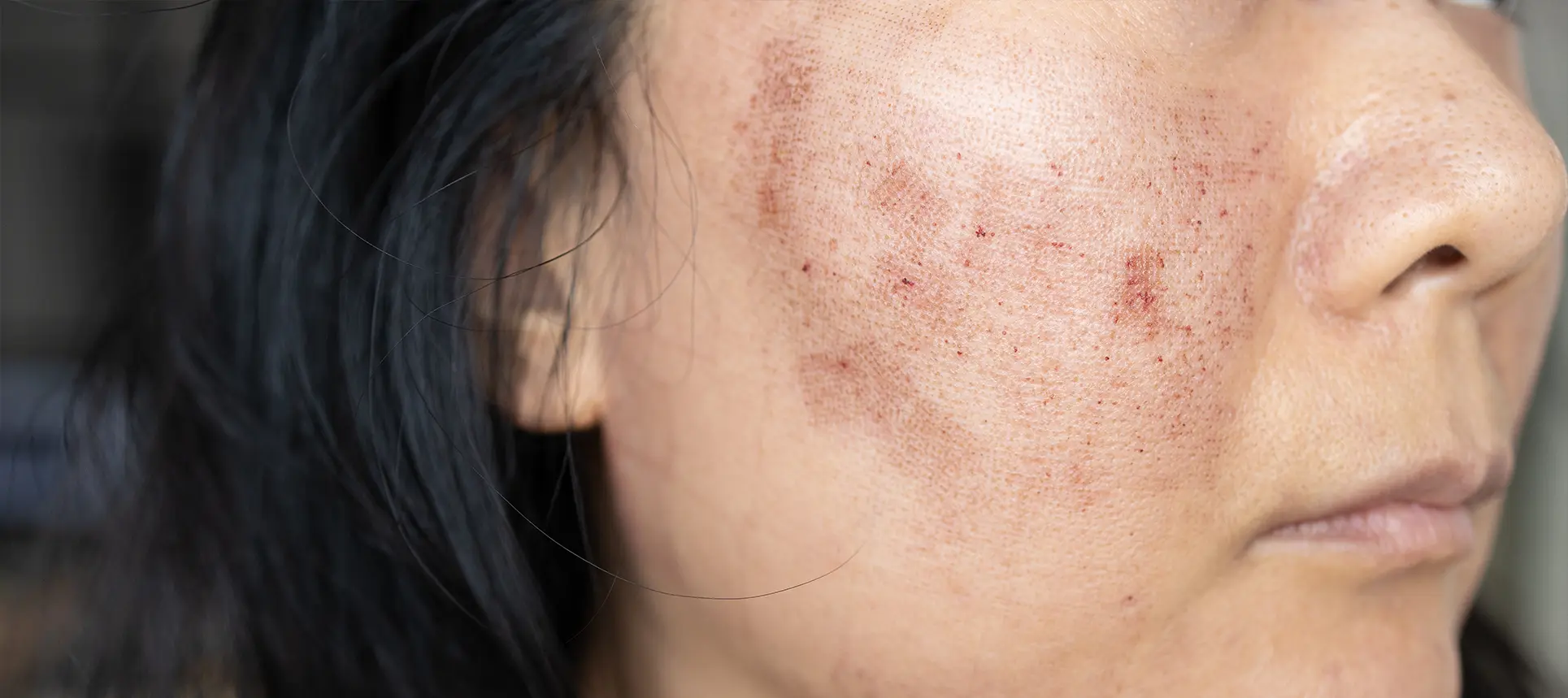Pigmentation problems might seem like something you can fix with the right cream or a quick laser session, but the truth is far more complicated. What you’re seeing on the surface of your skin could be the result of a variety of underlying causes—and treating it blindly can often make things worse. That’s why consulting a dermatologist before diving into treatments is one of the smartest decisions you can make for your skin.
Pigmentation Isn’t Just One Thing
Let’s start with something most people overlook: pigmentation isn’t a single condition. It’s a broad term that covers a whole spectrum of skin discolourations. You might have melasma, sunspots (also called solar lentigines), post-inflammatory hyperpigmentation, or something entirely different. Each of these issues arises for different reasons and requires a different approach.
For example, melasma is commonly linked to hormonal changes and is notoriously stubborn. You can fade it temporarily with the right products, but if you don’t treat the underlying cause—or worse, if you irritate the skin with the wrong treatment—it’s likely to come back darker and more widespread. Compare that with post-inflammatory hyperpigmentation, which can follow acne, eczema or a minor injury. This type of pigmentation usually responds well to topical treatments, but even then, the wrong ingredients can cause more inflammation.
Sunspots, on the other hand, are due to accumulated UV exposure over time. These often respond to laser treatments, but only if diagnosed correctly. Using lasers on melasma or active inflammation can actually worsen the condition. That’s why it’s essential to know what you’re really dealing with before you start slathering on serums or booking laser appointments.
The Risks of Self-Diagnosing Your Skin
It’s understandable—you see a dark patch or uneven tone and head straight to Google or TikTok. Someone online swears by a miracle cream or a particular light-based treatment, and you’re tempted to give it a try. But pigmentation isn’t just a cosmetic issue; it can sometimes signal deeper skin concerns, and misdiagnosing yourself can lead to costly mistakes.
Pigmentation problems can sometimes mask other conditions like actinic keratoses (a pre-cancerous skin change), lichen planus pigmentosus, or even subtle forms of dermatitis. Without a trained eye, you won’t be able to tell the difference. Dermatologists are trained to spot these nuances and perform a thorough evaluation, which often includes using a dermatoscope or even ordering a skin biopsy.
Self-diagnosis also doesn’t account for how your skin will react over time. That new serum with acids or retinol might look promising, but if your skin barrier is compromised or inflamed, you could end up with burns, scarring, or worse pigmentation than before. Seeing a dermatologist helps you take a strategic, safe, and medically sound approach—something that no online review can provide.
Why Professional Evaluation Matters Before Using Creams
Over-the-counter pigmentation creams are everywhere—some contain hydroquinone, kojic acid, arbutin, vitamin C, or niacinamide. While these ingredients can be effective in the right context, they aren’t universal fixes. In fact, using them without proper guidance can sometimes do more harm than good.
Hydroquinone, for instance, is one of the most potent skin-lightening agents available, but it should never be used long-term without supervision. Misuse can lead to ochronosis—a condition where the skin becomes dark and thickened, ironically making pigmentation much worse. Then there’s the risk of allergic reactions or contact dermatitis from other “brightening” ingredients.
Even popular active ingredients like vitamin C can irritate sensitive skin types or lead to inflammation if used in high concentrations. Dermatologists tailor your treatment to your unique skin type, history, and lifestyle. They may recommend a prescription cream that’s more effective than anything available in shops, or they might suggest layering products in a specific way to avoid irritation. Either way, you’ll get a personalised approach rather than playing skincare roulette.
When Lasers Go Wrong: A Cautionary Tale
Laser treatments for pigmentation can yield stunning results—but only when done correctly. The wrong laser, the wrong setting, or the wrong timing can leave you with burns, scarring, or even permanently darker patches. And unfortunately, these mistakes are far more common than you might think when lasers are administered without medical oversight.
For example, many people with melasma seek out intense pulsed light (IPL) treatments, thinking it will brighten their complexion. In reality, IPL can worsen melasma by generating heat that stimulates pigment-producing cells (melanocytes). Likewise, fractional laser resurfacing can be highly effective for some forms of pigmentation but might trigger inflammation and rebound pigmentation in darker skin tones.
Skin type plays a huge role here. Fitzpatrick Skin Types IV–VI (which includes individuals with medium to dark skin tones) are more prone to post-inflammatory hyperpigmentation after laser treatments. A dermatologist will not only determine the safest laser for your skin type but will also pre-treat your skin to reduce the risk of side effects. They may even suggest alternatives like chemical peels or microneedling based on your specific condition.
The Importance of a Tailored Treatment Plan
Your pigmentation didn’t appear overnight, and it won’t disappear that way either. Effective treatment requires a combination of consistency, patience, and medical insight. A dermatologist can build a treatment plan that considers your skin’s needs today and its long-term resilience.

That plan might include prescription-strength creams, in-clinic procedures like chemical peels or laser therapy, and a supportive at-home routine. It might also include guidance on sun protection, hormonal evaluation, or dietary changes that could impact your skin health. What matters is that it’s built around you—not some generic routine picked up on social media.
Moreover, dermatologists monitor your progress and make timely adjustments. If a treatment isn’t working as expected or if your skin starts reacting negatively, they’ll switch things up quickly. That kind of responsive care simply isn’t possible with one-size-fits-all solutions.
Certainly! Here’s a new section you can add to the article, summarising the different treatment options for pigmentation problems. The content is 100% original and written in your requested UK English style and direct tone:
A Summary of Treatment Options for Pigmentation Problems
Once you’ve had your pigmentation properly assessed, your dermatologist will walk you through the available treatment options. These may be used on their own or in combination, depending on your skin type, the cause of your pigmentation, and how your skin responds over time. Here’s a quick breakdown of what might be recommended.
Topical Treatments
These are usually the first line of defence. Prescription creams often contain ingredients like hydroquinone, retinoids, azelaic acid, kojic acid, or tranexamic acid. These work by either slowing pigment production, increasing cell turnover, or calming inflammation. A dermatologist might create a compound formula tailored to your skin, often alternating between active and soothing ingredients to balance results with comfort. Over-the-counter options can also be helpful, but it’s vital to use them under guidance to avoid irritation or worsening of pigmentation.
Peels
Peels work by exfoliating the top layers of skin to fade pigment and stimulate renewal. Superficial peels using glycolic or salicylic acid are common for mild issues, while stronger peels may be used for deeper pigmentation. These are not a one-size-fits-all solution—your skin tone, history of sensitivity, and pigmentation type all determine what kind of peel (if any) is suitable for you. Peels can be particularly helpful for post-inflammatory hyperpigmentation and sunspots but may need to be done in a series for best results.
Laser and Light Treatments
For certain types of pigmentation, especially sun damage and stubborn patches, laser therapies like Q-switched lasers, Pico lasers, and fractional lasers may be recommended. IPL (intense pulsed light) is also commonly used. However, lasers require extreme care, especially on darker skin tones, as they can trigger rebound pigmentation if not handled correctly. Dermatologists will carefully select the type of laser, intensity, and number of sessions to minimise risks and maximise results.
Microneedling and Radiofrequency
Microneedling, often combined with radiofrequency, creates controlled micro-injuries to the skin, triggering collagen production and helping break up excess pigment. This treatment is particularly useful for treating post-acne pigmentation and can also improve overall skin texture. When done by a professional, it can be a safe option for many skin types, including those more prone to pigmentation issues.
Oral Medications and Supplements
In some cases, dermatologists may recommend oral treatments. Tranexamic acid, for instance, can be taken in tablet form to help manage melasma. Antioxidant supplements like vitamin C, glutathione, or polypodium leucotomos may also be used to support skin health and reduce UV-related pigmentation triggers. These aren’t magic pills, but when combined with other treatments, they can boost results.
Sun Protection
This one isn’t optional—it’s essential. Every pigmentation treatment plan hinges on consistent and proper sun protection. A broad-spectrum SPF 30 or higher, worn daily and reapplied often, is your skin’s best ally. Dermatologists will also recommend physical barriers like hats and sunglasses, especially if you’re undergoing light- or peel-based treatments.
Ultimately, your treatment will be a blend of science, patience, and expert judgement. What works brilliantly for one person might not work for another, which is why professional guidance is key to getting it right.
The Role of Sun Protection in Every Treatment Plan
No matter what kind of pigmentation you have, sun exposure plays a role in making it worse. That’s why dermatologists always include sun protection as a central part of your treatment plan. But there’s more to it than just applying SPF once a day.

Dermatologists help you choose the right sunscreen for your skin type—whether it’s mineral, chemical, tinted, or fragrance-free. They also teach you when and how to reapply, which parts of the face people commonly miss, and why even indoor lighting can sometimes contribute to pigmentation (especially in people with melasma).
They’ll also educate you on lifestyle tweaks: wearing wide-brimmed hats, avoiding sun at peak hours, and using antioxidant serums that neutralise UV damage. These steps might seem minor, but they can make or break your treatment outcomes.
What to Expect During a Dermatology Consultation
If you’ve never seen a dermatologist before, it can feel a bit intimidating—but rest assured, it’s a straightforward process. During your consultation, the dermatologist will start by taking a full history of your skin, lifestyle, and medical background. They’ll then examine the pigmentation closely, often using specialised tools to see below the skin’s surface.
From there, they’ll give you a clear diagnosis and explain your treatment options. You’ll walk away with a customised plan, product recommendations (if any), and a follow-up schedule to track your progress. Most importantly, you’ll have the confidence of knowing that you’re finally addressing your pigmentation with the right level of care.
Why It’s Especially Important for Skin of Colour
Pigmentation issues are particularly common—and complex—in individuals with medium to dark skin tones. These skin types are more prone to both hyperpigmentation and hypopigmentation, and they respond differently to treatments. Many of the approaches that work well on lighter skin can actually cause damage in darker skin tones.
That’s why seeing a dermatologist with experience in skin of colour is essential. They understand the unique risks and are trained in the safest and most effective approaches for melanin-rich skin. From gentler chemical peels to lower-fluence lasers, they’ll tailor every step of your treatment to avoid complications.
Even something as simple as acne can leave lasting pigmentation marks if not treated correctly. And let’s face it—those marks can take months to fade without help. A dermatologist helps you stay ahead of the problem rather than trying to undo the damage later.
The Psychological Impact of Pigmentation
Skin concerns don’t just affect how you look—they affect how you feel. Many people with pigmentation issues report lower self-esteem, social anxiety, and frustration when treatments don’t work. This emotional toll is real, and it deserves proper attention.

Dermatologists recognise this. Many will ask how your pigmentation is impacting your quality of life and take that into account when recommending treatments. Sometimes, just knowing that there’s a medical professional guiding you can lift the burden. You no longer feel alone, overwhelmed, or misled by online hype.
And remember—pigmentation is treatable. You don’t have to live with it, but you do need the right support. That starts with seeing a dermatologist.
Final Thoughts: Get It Checked Before You Treat It
In a world overflowing with skincare hacks, influencer advice, and miracle cures, it’s tempting to try everything yourself. But when it comes to pigmentation, guessing your way through treatment can cost you time, money, and skin health.
A dermatologist helps you get it right the first time—by identifying the exact issue, recommending safe and effective options, and monitoring your progress. Whether your pigmentation is new or longstanding, mild or stubborn, the best place to start is always with a professional evaluation.
So, if you’re concerned about pigmentation, don’t wait. Book that consultation, get an expert diagnosis, and treat your skin with the care it deserves. If you’re experiencing pigmentation problems and would like to consult with an expert private dermatologist in London, you can get in touch with us at The London Dermatology Centre.
References
- National Institute for Health and Care Excellence (NICE). (2022) Melasma: Clinical knowledge summary. Available at: https://cks.nice.org.uk/topics/melasma/ (Accessed: 6 May 2025).
- Callender, V.D., St Surin-Lord, S., Davis, E.C. and Maclin, M. (2020) ‘Postinflammatory hyperpigmentation: Etiologic and therapeutic considerations’, American Journal of Clinical Dermatology, 21(1), pp. 75–90.
- British Association of Dermatologists (BAD). (2023) Chemical peels and your skin.
- Alexis, A.F., Callender, V.D. and Baldwin, H.E. (2019) ‘Laser and light therapy in darker skin types’, Journal of Clinical and Aesthetic Dermatology, 12(7), pp. 18–24.
- Sarkar, R., Arora, P., Garg, K.V., Sonthalia, S. and Gokhale, N. (2021) ‘Melasma update: Treatment and maintenance therapies’, Pigment International, 8(1), pp. 1–12.
